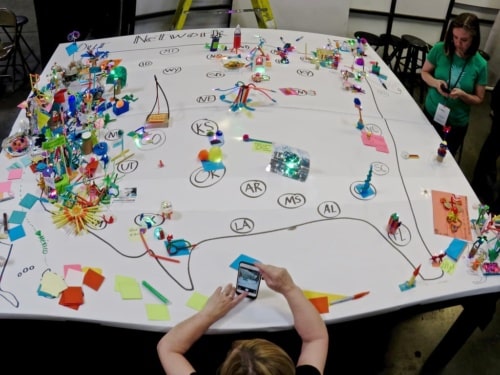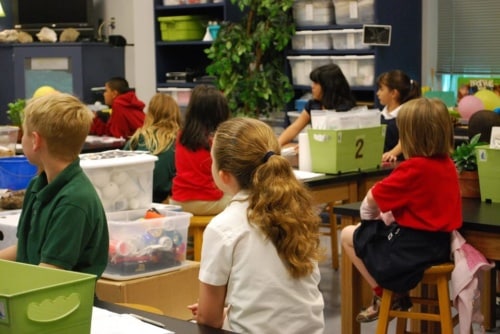Table of Contents
Building confidence and fluency with Project Based Learning by Brian M. Pete and Robin J. Fogarty
 What Is PBL in a Nutshell?
What Is PBL in a Nutshell?
PBL in a Nutshell is the Reader’s Digest version of Problem Based Learning. It’s a whole, yet, condensed problem-solving process that paves the way to introduce and integrate the life skills of the more robust problem-solving processes.
Why is Everyday Problem Solving Important?
The World Economic Forum Future of Jobs Report forecasted Complex Problem-solving as the most in-demand skill in 2015 and again in 2020, “The top trend in the report, though, is the changing nature of work. Work today is increasingly collaborative and focused on solving complex problems in creative ways (Schwab 2016).”
Why Does Everyday PBL Work So Well?
 In response, the first finding by Ericsson and Pool (2016) and Daniel Coyle (2009) is about building confidence and fluency with everyday problem solving through practice, coaching and motivating factors. These experts believe talent is made, not born and can be achieved when students are engaged in a process is called “deliberate practice.” Defined as multiple repetitions, not just drills, but engineered, reflective repetitions that require the learner to “reach and repeat” seem to be what raises the skillfulness, builds automaticity and develops true expertise. Without getting too far into the weeds, when deliberate practice, with the many iterations, motivated through coaching feedback is implemented, the neurons respond by wrapping myelin around the axon to strengthen pathways that send the messages (Coyle, 2009).
In response, the first finding by Ericsson and Pool (2016) and Daniel Coyle (2009) is about building confidence and fluency with everyday problem solving through practice, coaching and motivating factors. These experts believe talent is made, not born and can be achieved when students are engaged in a process is called “deliberate practice.” Defined as multiple repetitions, not just drills, but engineered, reflective repetitions that require the learner to “reach and repeat” seem to be what raises the skillfulness, builds automaticity and develops true expertise. Without getting too far into the weeds, when deliberate practice, with the many iterations, motivated through coaching feedback is implemented, the neurons respond by wrapping myelin around the axon to strengthen pathways that send the messages (Coyle, 2009).
Why Wholeness Matters
The second finding that supports PBL in a Nutshell as a highly desirable learning strategy is couched in the profound thinking of David Perkins (2010) in Making Learning Whole. As he describes the power of contextual learning or wholeness, believing that all learning is contextual. When learners have the “big picture” in mind, it provides relevancy that affords easier transfer to similar and remote situations.
Why is it not that complicated?
 Finally, PBL in a Nutshell is about transforming the everyday classroom lesson into an inquiry in which students take the reigns and own the task, the processes and the product. Naturally, they are first talked and walked through the PBL process to get their footing, yet, as soon as you have evidence that you can release responsibility to the student teams to handle the PBL inquiry. “It’s not that complicated”. Yes, it is different, it does take time, and it needs collaborative, teacher support on how to extract a PBL lesson from traditional, typical content lessons. That is the shift to 21st Century schooling that is on today’s agenda: critical and creative thinking, collaboration and communication to address the known and unknown challenges on the horizon.
Finally, PBL in a Nutshell is about transforming the everyday classroom lesson into an inquiry in which students take the reigns and own the task, the processes and the product. Naturally, they are first talked and walked through the PBL process to get their footing, yet, as soon as you have evidence that you can release responsibility to the student teams to handle the PBL inquiry. “It’s not that complicated”. Yes, it is different, it does take time, and it needs collaborative, teacher support on how to extract a PBL lesson from traditional, typical content lessons. That is the shift to 21st Century schooling that is on today’s agenda: critical and creative thinking, collaboration and communication to address the known and unknown challenges on the horizon.
How Do Teachers Do PBL in a Nutshell?
The 7 Step Process in the Everyday PBL model is the same whether the assignment is 40 minutes or 4 days. With the PBL in a Nutshell Seven Step Guide, the process is spelled out: Form an essential question, develop problem scenario & stakeholder role(s), gather resources, organize information, create evidence, present findings, and assess results.
What is an Example of PBL in a Nutshell?
Middle School Persuasive Prompts for Student Teams:
Your principal wants to invite a celebrity speaker to your school. Think about the celebrity you would choose to speak; then, write a letter to persuade your principal to invite this person. Be sure to include convincing reasons and details to support your choice.
Here is the performance assignment adapted for the Everyday PBL Model:
- Essential Question:
How do people inspire each other?
- Stakeholder Role and Problem Scenario:
 You are in charge of booking talent for your next school assembly. You also have mastered time travel so that you can book any person from history, alive or dead, to speak at your school.
You are in charge of booking talent for your next school assembly. You also have mastered time travel so that you can book any person from history, alive or dead, to speak at your school.
You will first roll the dice to generate a random number from 1 to 6.
When the teacher reveals the list of famous people on the board you will have to do research the person you chose, keeping in mind the Essential Question, “How do people inspire each other?”
Your product will be a persuasive essay designed to convince your principal to invite this particular historical figure. Your essay will use at least 6 facts about your character with citations. The following facts: date of birth, date of death and place of birth can be included but do not count toward the 6 facts.
- Gather Resources
You will use the internet or resources in the classroom to conduct research on your subject. You must document the internet sites visited and/or the books or magazines used.
- Organize Information
You will take your list of resources and number them in the order of importance, in terms of making your argument in the essay.
- Create Evidence
 You will write a persuasive essay of at least 4 paragraphs using at least 5 for the facts that you discovered, not including the subject’s date of birth, date of death and place of birth.
You will write a persuasive essay of at least 4 paragraphs using at least 5 for the facts that you discovered, not including the subject’s date of birth, date of death and place of birth.
- Present Findings
You will be prepared to meet with 5 other students, who chose a different historical figure based on the roll of the dice and share a summary of what you have learned about your character.
You will, as a group of 6 students discuss the similarities and differences of your subjects.
- Assess Results
 You will prepare a summative assessment of the written work including the list of researched facts with citations.
You will prepare a summative assessment of the written work including the list of researched facts with citations.
Some may say, “This is too difficult for my students.” But that is true for any introductory task unfamiliar to students. It’s okay if they struggle a little. That informs you of the skills that need attention. Through coaching and feedback, mini-lessons, micro-skill practice and even one-on one-tutorials, teachers can adjust and modify as they clarify and reinforce the learning when it’s needed. In fact, this type of scaffolding will lead to independent, self-regulating 21st Century citizens.
Give it a go! See where it takes the learning and the learners in care.
Resources
Coyle, Daniel. The Talent Code: Greatness Isn’t Born, It’s Grown. London: Arrow, 2010. Print.
Perkins, David N. Making Learning Whole: How Seven Principles of Teaching Can Transform Education. San Francisco, CA: Jossey-Bass, 2009. Print.
Ericsson, Karl Anders, and Robert Pool. Peak: Secrets from the New Science of Expertise. London: Bodley Head, 2016. Print.
Author
Brian Pete is president and cofounder of Robin Fogarty & Associates, an international educational consulting firm. Follow Brian on Twitter.
Robin Fogarty is president of Robin Fogarty & Associates. She has a doctorate in curriculum and human resource development from Loyola University Chicago. Follow Robin on Twitter.
They are co-authors of the recently released book Everyday Problem-Based Learning: Quick Projects to Build Problem-Solving Fluency.
Further Reading
- The Sentinel – Adapting to AI: Future brings focus on project-based learning
- The Journal – Project-Based Learning: ‘Promising but Not Proven,’ Researchers Say
- ADDitude – How Project-Based Instruction Can Ignite Your Child’s Love for Learning



 What Is PBL in a Nutshell?
What Is PBL in a Nutshell?